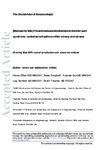Present status and advances in bladder pain syndrome: central sensitisation and the urinary microbiome
| dc.contributor.author | Offiah, I | |
| dc.contributor.author | Campbell, R | |
| dc.contributor.author | Dua, A | |
| dc.contributor.author | Bombieri, L | |
| dc.contributor.author | Freeman, R | |
| dc.date.accessioned | 2022-06-06T10:25:52Z | |
| dc.date.available | 2022-06-06T10:25:52Z | |
| dc.date.issued | 2022-05-07 | |
| dc.identifier.issn | 1467-2561 | |
| dc.identifier.issn | 1744-4667 | |
| dc.identifier.uri | http://hdl.handle.net/10026.1/19278 | |
| dc.description.abstract |
Key content Bladder pain syndrome (BPS) presents as a spectrum of urological symptoms with poorly understood pathophysiology. Bladder mucosal injury secondary to low grade sub-clinical infection is a possible trigger, leading to nociceptive upregulation and, subsequently, central sensitisation. Brain abnormalities associated with BPS suggest that neuropathological brain alterations exist, which may contribute to the perceived pain. Central sensitisation plays a role in the disease pathophysiology via an augmentation in the responsiveness of the central pain signalling neurons. The urinary microbiome is implicated as a trigger for the development and maintenance of BPS. Future directions to improve treatment strategies include stratification of patients with BPS into subtypes such as peripheral or central disease and investigation of the urinary microbiome and bladder barrier replacement. Learning objectives To update clinicians’ knowledge of current research into the urinary microbiome and pain sensitisation in BPS pathophysiology. To understand the biodiversity and abundance of urinary microbes and the role of peripheral and central pain sensitisation, which will help identify future management techniques for BPS. Ethical issues What are the consequences of long-term antibiotics use for BPS management on bacterial resistance? | |
| dc.format.extent | 159-166 | |
| dc.language | en | |
| dc.language.iso | en | |
| dc.publisher | Wiley | |
| dc.subject | Pain Research | |
| dc.subject | Neurosciences | |
| dc.subject | Urologic Diseases | |
| dc.subject | Chronic Pain | |
| dc.subject | Clinical Research | |
| dc.subject | 2.1 Biological and endogenous factors | |
| dc.subject | Neurological | |
| dc.subject | Renal and urogenital | |
| dc.title | Present status and advances in bladder pain syndrome: central sensitisation and the urinary microbiome | |
| dc.type | journal-article | |
| plymouth.issue | 3 | |
| plymouth.volume | 24 | |
| plymouth.publication-status | Published | |
| plymouth.journal | The Obstetrician and Gynaecologist | |
| dc.identifier.doi | 10.1111/tog.12807 | |
| plymouth.organisational-group | /Plymouth | |
| plymouth.organisational-group | /Plymouth/Faculty of Health | |
| plymouth.organisational-group | /Plymouth/Faculty of Health/Peninsula Medical School | |
| plymouth.organisational-group | /Plymouth/REF 2021 Researchers by UoA | |
| plymouth.organisational-group | /Plymouth/REF 2021 Researchers by UoA/UoA01 Clinical Medicine | |
| plymouth.organisational-group | /Plymouth/Users by role | |
| plymouth.organisational-group | /Plymouth/Users by role/Academics | |
| plymouth.organisational-group | /Plymouth/Users by role/Researchers in ResearchFish submission | |
| dcterms.dateAccepted | 2022-05-07 | |
| dc.rights.embargodate | 2022-6-7 | |
| dc.identifier.eissn | 1744-4667 | |
| dc.rights.embargoperiod | Not known | |
| rioxxterms.versionofrecord | 10.1111/tog.12807 | |
| rioxxterms.licenseref.uri | http://www.rioxx.net/licenses/all-rights-reserved | |
| rioxxterms.type | Journal Article/Review |


